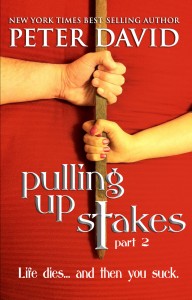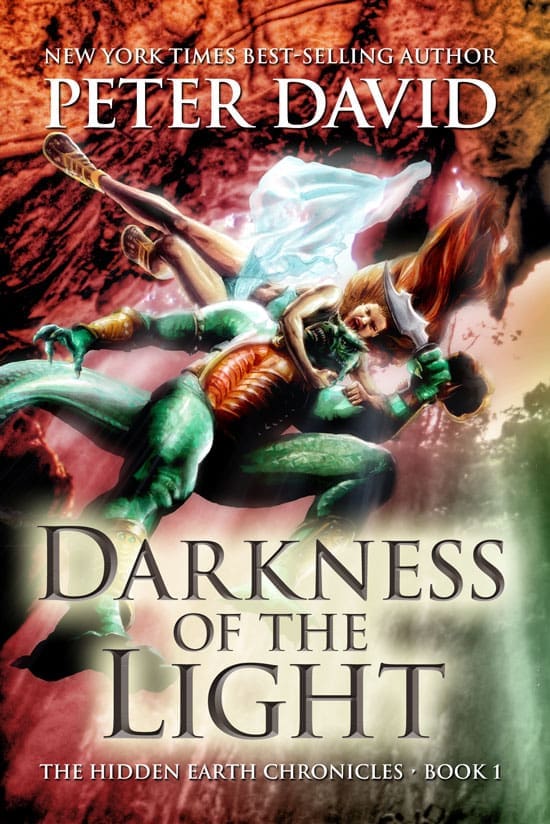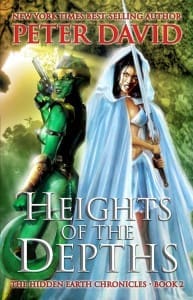 Originally published February 2, 2001, in Comics Buyer’s Guide #1420
Originally published February 2, 2001, in Comics Buyer’s Guide #1420
Once upon a time in comics, it was simple: No one really gave a dámņ about what other people were doing.
So when a new origin for a character cropped up, it needed no reason other than that a writer or editor (or both) had come up with what they thought was an interesting twist on the hero’s origin. Or perhaps it was nothing more complicated than that they had a ten-page space to fill that month and they were fresh out of ideas for new stories, so they decided to recycle the hero’s birth one more time.
And then there was the fact that heroes in different comics could go to Mars (for instance) and run into totally different races. Which, when you get down to it, is really more accurate than the way it’s usually done in comics where a race has a uniform look to it. In real life, different extraterrestrial visitors, if they opted to drop in on earthlings, would come back with wildly different stories depending on where they happened to visit. It would be the science fiction equivalent of the old story of five blind men feeling up an elephant, and each describing a totally different animal depending upon what part they were grasping. Same deal for newcomers to this world. (“Their skin is dark!” “No, its pigmentation is light!” “Their eyes are very narrow!” “No, they’re somewhat round.” “They cover themselves in clothing!” “No, they wear very little, and their women go around topless… although, oddly, photographers from National Geographic seem to follow them around.”)
But those were the old days, when spontaneity ruled and the average attention span of a comic book reader covered four years, tops, before he (usually a “he”) moved on to other stuff, like girls. Things are very different now, and fans desperately want to believe that there’s some sort of grand plan or overview at the major companies. Fans have asked me questions along those lines, inquiring as to the existence of lengthy overview books at Marvel or DC, supposedly written decades ago which detail—without fail or exception—every move that the major companies make with the characters. As if, with twenty years warning, Marvel still couldn’t have figured out that the Spider-clone was a bad idea.
And if something gets changed now, the change itself isn’t enough. It isn’t sufficient that it makes sense within the context of the story in which it appears. It has to make sense within the context of every story that preceded it. There’s even a term when some change comes along that reorders or redefines the earlier narratives. It’s called a “retcon,” short for “retroactive continuity.” People do so like to give things names, don’t they.
What becomes really entertaining is that there will always be those who don’t like the changes that are made, who disdain the retcons. Fans seem to think that they have a monopoly on resenting bad ideas. That they’re the only ones who might read a story and think, “Why the hëll did they do that?” But that’s not the case. Many folks in the industry are little more than fans who grew up and “made good,” and we’re just as liable to read something and moan about it. We just moan differently, that’s all. A fan will read a bad story and say, “What were they thinking?” The pro will read the same bad story and said, “(Fill in name of creator), what were you thinking?!”
The fans simply gnash their teeth or pour out their grief to their fellows on line or at conventions, or write their own fan fictions designed to correct the matter (and hey, I’m the guy who wrote a two-part Beauty and the Beast/Quantum Leap crossover just so I could have Sam Beckett take over the body of Vincent and undo the entire crappy third season of B&B. So I know what I’m talkin’ here.) However, sooner or later, with the occasional exception, fan protests will die down and they will become caught up in whatever new story wrinkles are going on. They may not forget the changes that got them riled up, but they’ll stop worrying about them.
Pros, on the other hand, not only don’t forget, but they don’t stop worrying about it. That which bothers them, they fix. That which doesn’t bother them, they sometimes pick up and run with.
Witness Superman #166.
For years, Superman’s origins had had roots in tragedy that were on an even greater scale than Batman’s. Here was Krypton, a scientifically advanced, vital and flourishing world. A place so wondrous, so touched by fortune and greatness, that the notion that the world was doomed—a prediction voiced Cassandra-like by leading scientist Jor-El—was literally unthinkable. Krypton couldn’t be doomed because, dammit, it was Krypton.
And then there was awful choice that Lara, Kal-El’s mom, was faced with in Krypton’s dying throes. She could have climbed into the ship with her baby. She could have been there to nurture him, protect him. Instead she made the conscious choice to die with her husband instead of survive with her infant son. Man, that’s the kind of psychological angle that you could get tons of stories out of; Superman, however, was far too well adjusted to dwell on the concept of mom preferring to abandon her child to fate and deep space rather than live without dad. Still, the drama was there for the reader, even if it did seem a bit wasted on the guy in blue.
And then Superman was relaunched, and suddenly Krypton was sterile and cold and kinda dull. There was no tragedy to its annihilation because you didn’t give a dámņ about the inhabitants. Kal-El was no longer a cherubic, smiling infant, but a “birthing matrix” or some such. He was more a note-in-a-bottle from a deservedly dying world than a refugee from a wrenching emotional Hobson’s choice, flung from a thriving world cut down in its prime.
There was good stuff that came out of the relaunch of Superman… most conspicuously Ma and Pa Kent remaining vital players in the DC mythos instead of dying before Superman’s career even started. As for the retooled Krypton, however, well… it was a way to go. It’s not the way I would have gone, but it was a choice. For better or worse… forever and ever…
Well… not necessarily.
In the old days, if new writers decided they disliked the sterile, movie-esque look of the new Krypton, they could just have done a story depicting Krypton in flashback, without explanation, and had it look the way they wanted it to. But as noted earlier, everything has to dovetail. So now we learn that the dispassionate Krypton we’ve accepted as “reality” was, in fact, a “memory implant.” Turns out Superman’s head has been messed with and that the big, major revelation is that Krypton was, in fact, exactly as we remembered it from the old stories, right down to Jor-El’s signature ensemble with the headband, green tunic and sun burst emblem.
Why? Because not all retcons are created equal, that’s why. Sometimes, it seems, writers look back on what was done and say, “Nah… I don’t like that. It was better the other way,” because the new version seems a betrayal of what they liked about the heroes when they themselves were fans.
Proofreaders or copy editors will sometimes make a change in a manuscript and then think better of it and decide that their change should be ignored. That words originally intended to be deleted should be left in, or that the original phrasing should be maintained. In order to inform the typesetter of this, the copy editor will write “stet” next to the change and circle it. “Stet” is derived from the Latin meaning, “Let it stand.”
So if deciding that Krypton was a sterile world filled with people who dressed in outfits that looked like a melding of Bob Mackie and Edward Gorey, and baby Kal-El was a birthing matrix, was a “retcon”…why, then, any story which undoes a story that others have thought better of can best be termed a “stetcon”: A continuity revision that puts it back the way it was in the first place. A stetcon is a repudiation, a “whoopsie, we don’t like that anymore.”
What’s interesting is that the very same issue presents an even greater curiosity: A retcon of something that didn’t actually happen.
The general belief (thanks to the opinions of DC war-guy supreme, Bob Kanigher) was that the indomitable Sergeant Rock not only died at the end of World War II, but the bullet that nailed him was the last bullet fired during the war… a demise that was best summed up by daughter Gwen who said, with typical teen empathy, “Sucks to be him.” Well, guess what. Rock is not only alive, but he’s on Lex Luthor’s cabinet. How whacked is that? It’s like Bob Hope being the opening act for Andrew Dice Clay. Sort of a retnoncom. Why is this being done? What is the most mythic soldier in DC’s history, a genuine relic of World War II, generally accepted to have died heroically (if a bit over-ironically) doing side-by-side with Luthor, a guy who made Hitler look like Fozzie Bear?
Why, for the same reason Krypton got dull: Someone thought it was a good idea. And if a couple of years from now, it’s revealed by another writer that Rock really did die sixty years ago and this guy’s an imposter, you’ve got another stetcon.
Ultimately, it’s a way for writers to keep the comics interesting and entertaining for themselves. They don’t like being told that the stories they enjoyed don’t “count” any more than any other fan does. It’s just that the writers are in a position to do something about it. And they’re aided and abetted by the fan desire to see everything fit together, to form some great logical mosaic.
There will always be stories that fans don’t accept. Where the heroes do something so completely wrong, or there’s a story development so completely preposterous, that the readers will shake their heads and say, “Unh unh. I don’t buy it.” Thing is, when a writer reads one of those, and is then able to do something about it, it’s often too tempting to resist. In which cases the writers can pat themselves on the back and say that they’re indulging in that most revered and appreciated act of creation, namely, giving the fans what they want. Fans rarely will say, “I want to read stories that demolishes everything I ever liked about the character.” The thing is, changes are usually made for a reason beyond that it seems like a good idea. Usually it’s to infuse a new direction in something that’s seen as old and stale. So if you’re going to produce a stetcon, you’d dámņëd well better be prepared to come up with not only a good reason for it, but a story that will justify it. Otherwise it’s just thumbing your nose at another writer and saying, “Ha ha, your story sucked, I changed it back, and yoouuu can’t stopppp me.”
And why are fans so obsessed with everything fitting together, forming an unbroken narrative replete with retcons, stetcons and the like? Why, they’re no different than anyone else, really. People look at a world that makes no sense, one where good people suffer for no reason, where tragedies cruelly occur, and they will seek reason and rhyme in the chaos. And that seeking, more often than not, will lead them to conclude, “It’s God’s will.” Better to believe that a Supreme Being would indulge in actions bordering on the sadistic (but for some higher and unseen purpose) than to think that it’s all just random chance, no one’s overseeing anything, and all the devotion and piety in the world doesn’t elevate your chances above anyone else’s.
Same deal here. Fans pray to the writers of the comic universes, hoping against hope that there’s really a grand scheme and we all know what we’re doing. We are comic book gods.
Think it’s an over aggrandizing view to take? I beg to differ: Why else are we referred to as “creators?”
(Peter David, writer of stuff, can be written to at Second Age, Inc., PO Box 239, Bayport, NY 11705.)





I enjoyed this article immensely, given how it puts the current continuity nonsense into perspective.
My wife and I started getting into Batman in a big way, just in time for DC to impose its “New 52” plan on the universe. I’m not sure why they felt the need to force all past continuity into a five year time frame; fans were perfectly willing to accept that the stories from the 40’s and 50’s “happened” to a hero who didn’t seem to be a day over 35. As I snapped up every “prime universe” trade paperback I could, I was amazed at how many great stories fell victim to the condensed timeline: Batman must have spent no more than a year with each Robin, Barbara Gordon was never a librarian (and so “The Killing Joke” must have happened differently, or else all those book puns the Joker made make no dámņ sense)and never became Oracle, “No Man’s Land” was simply impossible in the condensed timeline, Damian Wayne was now grown and matured in a test tube instead of being raised from birth to conquer the world(making his signature sense of entitlement less endearing), and the arc in which Bruce Wayne had returned from the dead and let Ðìçk keep the Bat-mantle (showing some actual progression and maturity in both characters) was retracted. Compare that with the editorial direction of the 80’s and 90’s, where they just said, “Hey, everyone loves the back story shown in ‘Batman Year One’. Let’s make all out future books consistent with that!”
Retcons are almost always justified by saying that new fans need an easy path into the characters. The one thing I love about PAD’s comics is that they respect established continuity, but tell new stories which are accessible to casual readers. I loved the last incarnation of X Factor, even though I had never read any of Monet’s convoluted history, nor anything involving Shatterstar or the Mojoverse. I picked up this week’s “Spiderman 2099” and both understood and enjoyed it, even though I have only read a few issues of the original run. If editors are serious about getting new readers, they should focus less on reworking the past and more on fresh starts that make readers wonder, “What comes next?”
Retcons used to mean revealing something new that fit into existing continuity. At the time the term was coined, Roy Thomas was using it to fit All-Star Squadron stories into the previously established history of the Justice Society.
Somewhere along the line, the term was subverted into covering wholesale reboots and alterations. At this point, we’ve gone through so many restarts on some of these characters that it’s just become ridiculous.
Crisis on Infinite Earths was intended to clear the clutter of alternate versions of the same characters. But with every reboot, we recreate that exact problem. We had the Silver Age Krypton for decades. Starting with Man of Steel though, we had Byrne’s version, a mix of Silver and Byrne, a move towards making it look more like the movies when Richard Donner was writing, the Birthright version, and now New 52, and probably a few more in-between. It really makes it hard to care about any of them with the changes coming so quickly in just a relatively small number of years.
Personally, the only retcons I enjoy are the ones that change the way of looking at the past without actually changing the past. When Alan Moore took over SWAMP THING, he changed not what happened to Alec Holland (blown up in the middle of his plant experiments) but what we assumed happened (Alec actually died, while the planarian worm-type plants absorbed his memories and thought they were Alec). Likewise, in Grant Morrison’s DOOM PATROL, he made the Chief an actual villain who has been throwing the team into peril to see what would happen — and it worked fine with the team’s given history.
(A cinematic parallel would be the movie WITHOUT A CLUE, a comedy where we learn that Dr. Watson was the real genius detective, but he was afraid being known as a detective would hurt his getting into a conservative school, so he invented the character Sherlock Holmes and hired an actor to play him. Same facts, different view.)
And if a couple of years from now, it’s revealed by another writer that Rock really did die sixty years ago and this guy’s an imposter, you’ve got another stetcon.
And, within about a year of this column, at the conclusion of a Rock-led Suicide Squad series, “Rock” peeled off a mask and left the team, who were advised that Frank Rock died in 1945.
–Daryl
Really? I don’t remember that.
PAD
Yep. Final issue (#12) of the 2001 series. Although looking it up, I was remembering it slightly differently. I thought I remembered the mask removal on panel, but it wasn’t. Going into the cell block where Rock had been held (and we’d last seen him), Deadshot found the mask.
http://dsx2001.net/images/SuicideSquad012-020.jpg
(The blond guy was supposed to be Bulldozer from Easy Company, and was supposedly confined to the wheelchair he gets out of on the page.)
On the final page, during a debriefing, Amanda Waller gives the final panel reveal.
http://dsx2001.net/images/SuicideSquad012-022.jpg
–Daryl
A related phenomenon would be the “Mopee,” in which a writer or perhaps editor comes up with some twist that he (and he alone, excepting perhaps the editor at the time if the idea came from the writer) thinks is really cool.
But the idea is actually so lame that everyone from then on, without any agreement or collaboration of any kind, just decides to ignore it forever. It never happened. It’s not even given the dignity of a “stetcon” story undoing it.
“Mopee” is of course the “heavenly helpmate” character who in one issue of the Silver Age The Flash was revealed to have caused and guided the lightning bolt that struck the rack of chemicals that gave Barry Allen his super-speed. That was never referred to again except in humorous fourth-wall-breaking manner by Ambush Bug and the like. Both the creators and the fans decided to simply ignore it, without any formal or informal agreement to do so. There was no explanation as to why the Mopee thing was false and relegated to “never happened.” It wasn’t a hoax, a dream, nor even an Imaginary Story.
Other examples include the story that “revealed” that Jor-El and Lara survived the explosion of Krypton by launching themselves in suspended animation in a larger second rocket, but that it got trapped in a cloud of “Kryptonite radiation,” which was green but of a variant that any Kryptonian exposed to it would contract a permanent and fatal case of Kryptonite poisoning that would persist even after the Kryptonite was removed. The ship itself was lead-lined so Jor-El and Lara were still alive, yet though Kal-El tried to retrieve them, there was no way to do so without exposing both him and them to the radiation which would mean certain death. So, he left them floating there in space, in suspended animation, surrounded by deadly radiation, forever.
Again: this was simply ignored. No story to the best of my knowledge ever explicitly explained away or undid this specific story (not counting universal retcons such as Crisis on Infinite Earths or New 52), but neither was it ever even hinted that Jor-El and Lara were still alive out there.
Anyone know of any Marvel “Mopees”?
The current Original Sin mega-wasteoftime is chuck-full of Mopees. All of the spinoffs reveal amazing things about the heroes’ pasts; things that will never be mentioned again once the series ends.
I was wondering how I knew what you were talking about.
Then you said Ambush Bug and I realized my current reading explained everything about why I knew the name and the (ignored) Flash event.